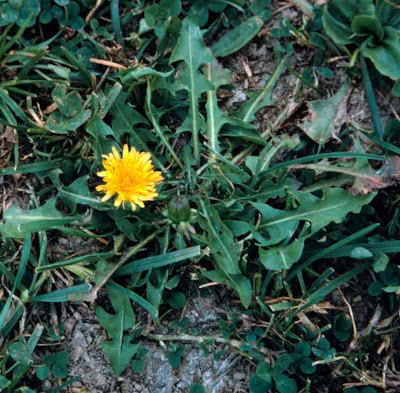 |
| Image of a dandelion, Taraxacum officinalis, from the University of Kentucky |
Last week, at the "Heirloom Vegetables" workshop at the Casey County Library, Julie Maruskin said one of the most memorable and funny things I've heard in a while: that the women shopping for the now trendy high-priced dandelion greens at urban high-end produce markets are probably the same women that have ChemLawns at home! Furthermore, that these greens, billed as the more gourmet-sounding "French-Italian Dandelions" are the very same ones that come out of any American lawn! Dandelions have always been considered a highly nutritious and excellent spring green by mountain people or farmers.
However, the somewhat lowly dandelion has had a bad rap with anyone who wants the perfect lawn. Fortunately, most country people aren't too fussy about their lawnscapes and, while lawn-mowing is an enjoyable pastime or necessity for some, you do see other lawns that are more naturally wild and tolerant of the errant "good" weed. Our lawn is sort of a combo: we mow off what's there when necessary but we also have what are considered weeds peppered throughout the grass and we don't believe in spraying our lawns. [After all, the true definition of a "weed" is any plant that is in an undesirable place.]
The well-tended lawn, in the history of landscape design, is a relatively new phenomenon. Historically, farmers have grazed their livestock right near their dooryards––and some still do (even President Woodrow Wilson grazed sheep earlier in the 20th century on the White House lawn). Kitchen gardens were generally fenced in or also near the back door and often every available bit of yard was used to grow food.
My only culinary experience with dandelions to date was tasting the annual wine that my green-thumb grandfather liked to make (I believe with the blossoms), on the family farm in the northeastern end of the Appalachian mountains back in New Hampshire. It was bitter and blech. Of course, I was much younger at the time and I have not had the pleasure of trying dandelion greens while they are new and fresh. I imagine it's like having a good "high end" salad mix.
One of my favorite blogs is Blind Pig and the Acorn, written by a woman named Tipper from the mountains of North Carolina. Here she details many Appalachian customs, sayings, history, folklore, gardening (including planting by the signs), music and other traditions, as well as old-time recipes. She is a regional treasure! Here are three of her blog posts that have talked about dandelions or lawn-as-food (including one on "kilt lettuce," a culinary custom that Julie Maruskin also mentioned in her talk the other day):
• On "Garden or Lawn"
• On Dandelion Jelly"
• On "Kill Lettuce"
[Make sure you read all of the comments after her blog posts because they are also informative!]
My daughter, from afar, just reminded me on the phone that she had to learn all of this poem in grade school, "To the Dandelion," by James Russell Lowell. Here is an excerpt from his ode:
Dear common flower, that grow'st beside the way,
Fringing the dusty road with harmless gold,
First pledge of blithesome May
...thou art more dear to me
Than all the prouder summer-blooms may be.
Do you have any recipes or stories involving dandelions?

After a column I wrote last year about dandelions, Frank van Dorsten gave me a small bottle of his dandelion wine. It was delicious! Here's his recipe:
ReplyDeleteFRANK’S DANDELION WINE
Frank Van Dorsten
Pour a gallon of boiling water over 3 quarts of thoroughly washed dandelion blossoms. Cover and let stand overnight.
In the morning, strain off liquid.
Add 3 1/2 lbs. sugar and 4-5 sliced up lemons. Heat just enough to melt sugar.
Pour into a crock and cover with cheesecloth; let work for 2-3 weeks in a warm place.
After fermentation has ceased, strain, bottle, and seal for future “medicinal” purposes.
Make in the springtime.
Thanks Joberta! I really should try it--my grandfather's was very bitter but maybe his, too, was "medicinal"!
ReplyDeleteIs there an on-line link to your column on dandelions? That would be great to link here.